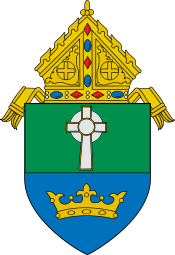Cathedral of Saint Patrick (Charlotte, North Carolina)
| Cathedral of Saint Patrick | |
|---|---|
|
Front view of the Cathedral | |
 | |
| 35°12′19.44″N 80°50′44.52″W / 35.2054000°N 80.8457000°W | |
| Location |
1621 Dilworth Road East Charlotte, North Carolina |
| Country | United States |
| Denomination | Roman Catholic Church |
| Website |
www |
| History | |
| Founded | 1938 |
| Consecrated | September 4, 1939 |
| Architecture | |
| Architect(s) | Frank Frimmer |
| Style | Neo-Gothic |
| Groundbreaking | 1938 |
| Completed | 1939 |
| Specifications | |
| Materials | Limestone |
| Administration | |
| Diocese | Diocese of Charlotte |
| Clergy | |
| Bishop(s) | Most Rev. Peter Jugis |
| Rector | Rev. Christopher A. Roux |
The Cathedral of Saint Patrick is the seat of the Roman Catholic Church in Charlotte, North Carolina, United States of America. It is the mother church of the Diocese of Charlotte and is the seat of its prelate bishop.
History
In 1843, St. Joseph Church in Mt. Holly was built. It was to be the first Catholic church in Western North Carolina.[1] On St. Patrick's Day 1852, the cornerstone was laid for the city of Charlotte's first Catholic church, St. Peter Church. Work was completed in 1893.
St. Peter Church was under the care of the Benedictine monks from Belmont Abbey. A neighboring convent of the Sisters of Mercy, also in Belmont had operated a school in Charlotte known originally as St. Mary's Seminary. The name was later changed to the O'Donoghue School, and in September 1930 it was moved to the Dilworth neighborhood. It was not until the 1930s that an additional church was needed to accommodate the growing Catholic population of the region.
Construction
St. Patrick Church was built adjacent to the O'Donoghue School, in the Dilworth neighborhood.[2] John Henry Phelan of Beaumont, Texas donated the funds to build St. Patrick Church, in loving memory of his parents, Patrick and Margaret Adele Phelan. Construction of the church began on St. Patrick's Day, 1938.
A Catholic grade school was built on the property in 1930. A rectory and convent were completed in 1941, and in 1943, the school was expanded to include high school grades.[2]
Architectural features
Frank Frimmer, architect and native of Austria, known for remodeling Old World churches, designed and supervised construction of the church, with its gray stucco face, 400-seat nave, balcony and 77-foot (23.7m) tall tower.
Picture of Cathedral Facade
The altar contains relics of St. Jucundius and St. Justina, and two side chapels were crafted as shrines honoring the Blessed Virgin Mary and Saint Joseph. Stained glass windows, designed in Syracuse, New York, depicted the Annunciation, St. Patrick, St. Joseph's deathbed scene, King David with his lyre, St. Cecilia, and some events in the life of Jesus.[2]
Consecration
On September 4, 1939, Bishop Eugene J. McGuinness of Raleigh consecrated the church under the patronage of St. Patrick. It became the first church in North Carolina to be consecrated immediately upon completion and in 1942 became a parish, with Goldsboro-native Monsignor Arthur R. Freeman as pastor.[2]
Establishment of new diocese
During the next few decades, the influx of Catholics added to the need for ministerial presence in Charlotte, and three parishes grew from St. Patrick: St. Ann, St. Gabriel and St. Vincent de Paul.
On January 12, 1972, Pope Paul VI established the Diocese of Charlotte, and St. Patrick Church was designated the cathedral church. Msgr. Richard Allen, pastor at the time, was appointed the first rector.[3]
Renovation
The cathedral experienced a period of major renovation beginning in 1979. The original character of the building, including memorials and windows, were preserved while the church was modernized to current liturgical standards. A new altar was constructed from the marble of the original High Altar. Artwork of local and religious significance were added during this period, as well. Additionally, the original Moller pipe organ was replaced with a new one, designed and manufactured by W. Zimmer and Sons of Fort Mill,and installed in the balcony.[2]
The cathedral remained closed for six months. On June 10, 1979, Bishop Michael J. Begley of Charlotte presided over the celebration of the church's reopening.
The majority of renovative efforts to restore St. Patrick Cathedral to its original condition was completed by Easter of 1996, yet periodic work has continued. The altar, baptismal font, statues and ambo were given new prominence, and a hardwood floor was installed. The dark oak wainscoting from the 1979 renovation was removed to brighten up the cathedral and make it appear as it did in 1939.
Most recently, Stations of the Cross brought in from Maggie Valley, NC and a Celtic cross were added outside. A permanent copper roof was installed and completed on December 7, 2000.[2]
On March 28, 2007, a 700 pound bell was raised in the bell tower. The bell was a gift from Herb and Louise Bowers and family. It was originally cast in 1875 in St. Louis, MO. The bell was blessed after the 5:30 PM Mass on Saturday, March 31, 2007.
Father Paul Q. Gary served as rector of St. Patrick Cathedral from July 1996 until July 2008.
Very Reverend Christopher A. Roux is currently the Rector of St. Patrick Cathedral.[4]
See also
References
- ↑ Diocese of Charlotte Archives - Our Oldest Church. Diocese of Charlotte Retrieved 2009-09-17.
- 1 2 3 4 5 6 History of St. Patrick's Cathedral. St. Patrick Parish. Retrieved 2009-09-17.
- ↑ History of the Charlotte Diocese. Diocese of Charlotte. Retrieved 2009-9-17.
- ↑ Diocese Parish Directory, Contact information for St. Patrick Cathedral.
External links
Coordinates: 35°12′19″N 80°50′45″W / 35.2054°N 80.8457°W
